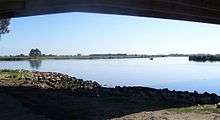Williams River (New South Wales)
| Williams River |
|
| Perennial stream |
|
| |
| Country |
Australia |
| State |
New South Wales |
| Regions |
NSW North Coast (IBRA), Hunter Region, Mid North Coast |
| Local government areas |
Dungog Shire, Upper Hunter Shire, Port Stephens |
|
|
| Part of |
Hunter River catchment |
| Tributaries |
| - left |
Chichester River, Carowiry Creek, Black Camp Creek |
| - right |
Myall Creek (New South Wales), Tabbil Creek, Wallarobba Creek, Unwarrabin Creek, Chambers Creek (New South Wales), Tumbledown Creek, Stony Creek (New South Wales) |
| Towns |
Raymond Terrace, Seaham, Clarence Town, Dungog |
| Landmark |
Seaham Weir |
|
|
|
|
| Source |
Careys Peak, Barrington Tops |
| - location |
near Salisbury |
| - elevation |
747 m (2,451 ft) |
| - coordinates |
32°3′7″S 151°28′43.4″E / 32.05194°S 151.478722°E / -32.05194; 151.478722 [1] |
| Mouth |
confluence with Hunter River |
| - location |
Raymond Terrace, Hunter Region |
| - elevation |
1 m (3 ft) |
| - coordinates |
32°45′S 151°45′E / 32.750°S 151.750°E / -32.750; 151.750Coordinates: 32°45′S 151°45′E / 32.750°S 151.750°E / -32.750; 151.750 [2] |
|
|
| Length |
142 km (88 mi) |
|
|
| National park |
Barrington Tops NP |
|
|
| [3][4] |
|
The Williams River is a perennial stream that is a tributary of the Hunter River, in the Hunter Region of New South Wales, Australia.
Course and features
The Williams River rises on the southern slopes of the Barrington Tops below Careys Peak within Barrington Tops National Park, and flows generally southeast and south, joined by ten tributaries including Chichester River, before reaching its confluence with the Hunter River at Raymond Terrace. The river descends 749 metres (2,457 ft) over its 142 kilometres (88 mi) course;[4] through Dungog, Clarence Town and Seaham.
See also
Gallery
Confluence of the
Hunter and Williams rivers.
References
External links
|
|---|
|
| |
|---|
|
- Backwater
- Bakers
- Beean Beean
- Belbora
- Ben Halls
- Berrico
- Buggs
- Burrell
- Callaghans Swamp
- Clear Hill
- Dog Trap
- Mackays
- Mograni
- Myall
- Oaky
- Orham
- Pipeclay Gully
- Sandy
- Schofields
- Scotts
- Tindag
- Titaatee
- Tomalla
- Tuggolo
- Waukivory
- Wild Cattle
- Williams
|
|
|
| |
|---|
|
- Alderley
- Black Bullock
- Blue Gum
- Boggy
- Boomerang
- Booral
- Bungwahl
- Bunyah
- Candoormakh
- Carrington
- Carrs
- Caseys
- Deep
- Firefly
- Horse
- Kelly
- Khoribakh
- Kundle
- Kyle
- Lamans
- Lawlers
- Lewis
- Limeburners
- Little Branch
- Little Myall
- Martins
- Mill
- Monkey Jacket
- Oakey
- Pipers
- Scotters
- Sharpers
- Snapes
- Spring
- Sugar
- Talawahl
- Teatree
- Terreel
- Waterloo
- Whispering Gully
|
|
|
|
|
|
|
|---|
|
|
|
|
|
| Entertainment, sport and culture |
|---|
| |
|
|
|
|
| Historical |
|---|
| | Air transport | |
|---|
| | Defence | |
|---|
| | Education | |
|---|
| | General | |
|---|
| | Industry | |
|---|
| | Maritime | |
|---|
| | Natural disasters | |
|---|
| | People | |
|---|
| | Rail | | General | |
|---|
| | Railway lines | |
|---|
| | Railway stations | |
|---|
| | Trams | |
|---|
|
|---|
| | Wine making | |
|---|
| | World War II | |
|---|
|
|
|
| Infrastructure |
|---|
| | Transport | | Road | |
|---|
| | Railway lines | |
|---|
| | Railway stations | |
|---|
| | Bus | |
|---|
| | Air | |
|---|
|
|---|
| | Utilities | | Electricity generation | |
|---|
| | Water supply | |
|---|
|
|---|
|
|
|
|
|
|
|
|---|
|
Towns, suburbs
and localities | |
|---|
|
Other places and
points of interest | |
|---|
|
|---|
|
| Towns, suburbs and localities |
- Alison
- Allynbrook
- Anleys Creek
- Bandon Grove
- Barrington Tops
- Bendolba
- Bingleburra
- Black Camp
- Bonnington
- Bonnington Park
- Brookfield
- Brownmore
- Cairnsmore
- Cambra
- Camyr Allyn
- Cangon
- Carrabolla
- Cawarra
- Chads Creek
- Chichester
- Cintra
- Clarence Town
- Clarence Town West
- Clay Hill
- Colstoun
- Cooreei
- Coulston
- Crooks Park
- Dingadee
- Douribang
- Dungog
- Dusodie
- East Gresford
- Eccleston
- Elms Hall
- Fishers Hill
- Flat Tops
- Fosterton
- Glen Martin
- Glen Oak
- Glen William
- Gresford
- Halton
- Hanleys Creek
- Hilldale
- Kenilworth
- Kilbride
- Lennoxton
- Lewinsbrook
- Lostock
- Lyndhurst Vale
- Main Creek
- Marshdale
- Martins Creek
- Masseys Creek
- Maxwells Creek
- Melbee
- Mill Hills
- Mount Rivers
- Munni
- Paterson
- Pine Brush
- Quartpot
- Raglan
- Salisbury
- Sugarloaf
- Summerhill
- Tabbil Creek
- Tillegra
- Tillimby
- Torryburn
- Trevallyn
- Tunnibuc
- Underbank
- Upper Allyn
- Upper Chichester
- Vacy
- Wallaringa
- Wallarobba
- Wangat
- Webbers Creek
- Welshmans Creek
- Wirragulla
- Woerden
|
|---|
|
| Rivers and other waterways | |
|---|
|
| Other places and points of interest | |
|---|
 Confluence of the Hunter and Williams rivers.
Confluence of the Hunter and Williams rivers.